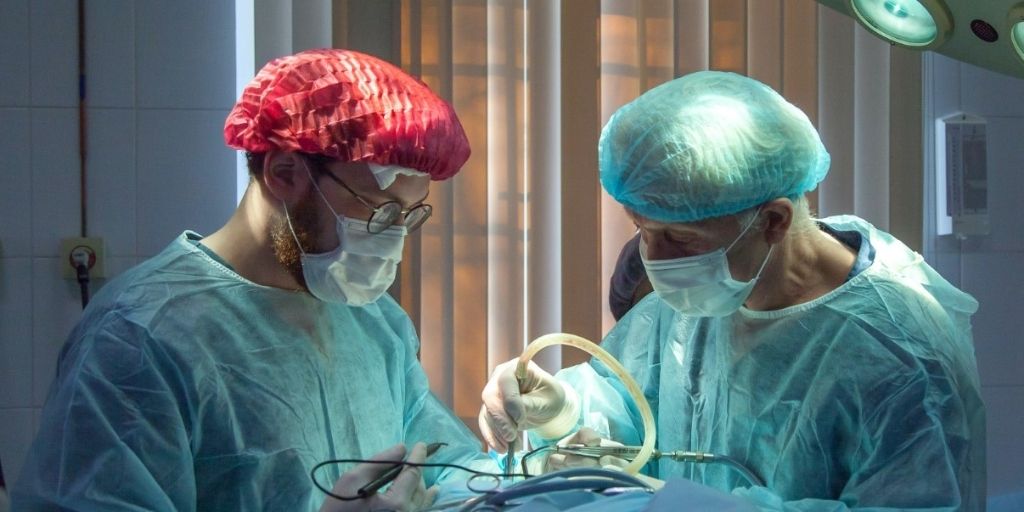
Researchers from the National Robotarium, a partnership between Heriot-Watt University and the University of Edinburgh, industry partners and Edinburgh-based clinicians are creating a new robot-assisted surgery technique to improve cancer surgical outcomes and patient care.
The ground-breaking method has been awarded £1.25 million and is funded by the Engineering and Physical Sciences Research Council, part of UK Research and Innovation.
It will be used during robotic surgery to help decide how much of the patient’s tissue is affected by cancer and should be removed. The new method will provide surgeons with real-time feedback, allowing for greater precision when differentiating normal from abnormal tissue.
The outer rim of tissue which the surgeon chooses to remove is known as the ‘surgical margin’. Currently, surgical margins are identified using the surgeon’s experience, preoperative imaging such as CT scans together with visual observations and, in open surgery, tactile ‘feel’. Another method involves sending specimens during the operation to the pathology lab for ‘frozen section’ which takes 15-20 minutes. However, when undertaking ‘keyhole surgery’ using laparoscopic, endoscopic (flexible telescope) or robotic operations, surgeons can’t use ‘feel’ to determine tissue characteristics.
Combining engineering, clinical, and industrial skillsets, the new collaboration will allow mechanical measurements to be taken inside and around the surgical target which will be interpreted using a set of ‘mechanical intelligence’ algorithms. The data will provide clinicians with a clear indication of a tissue’s disease status and determine how much tissue to remove during the operation.
The research team will work alongside industry partners IntelliPalp Dx and CMR Surgical along with leading clinicians working in the Western General Hospital in Edinburgh.
Dr Yuhang Chen from the National Robotarium is leading the research. He said:
“This new technique will offer surgeons a quantitative, real-time, reliable and evidence-based method for determining the optimal surgical margin to make when removing a tumour.
“Surgeons operating along a ‘keyhole’ or using techniques for minimally invasive surgery need to identify different structures or diseased areas, even when these look very similar. Our work is aimed at identifying the optimum margin in cancer surgery, to allow the removal of a tumour together with enough tissue to ensure the cancer is completely removed, but without excess being lost.
“We’re bringing together expertise from laser manufacturing, fibre-optic sensors, micromechanical probing and computational modelling to create a mechanical ‘imaging’ probe capable of detecting cancerous tissue that can be used with a standard minimally-invasive surgery instrument. Coupled to this, we’ll be building a ‘mechanically-intelligent’ data modelling framework and will integrate it into the probe operation for tumour identification and surgical margin assessment. This will effectively eliminate the margin of error for surgeons, giving them confidence that they have removed the correct amount of tissue during the operation itself and reduce the need for further invasive surgery for patients.”
Mr Hugh Paterson, consultant colorectal surgeon from the Western General Hospital in Edinburgh, said:
“Robot-assisted surgery is the next major development in minimally invasive surgery and has seen rapid development in its application for a wide variety of conditions. This project, however, will be one of its first applications to support and improve accuracy in cancer surgeries which is extremely exciting.
“Currently, although surgeons use detailed preoperative scans to decide on surgical margins during surgery, they also use vision and ‘feel’ to distinguish normal and abnormal tissue. ‘Feel’ is much reduced in key-hole surgery, and almost completely absent in robotic-assisted surgery. Margins can be particularly difficult to determine in confined spaces such as rectal or pelvic organ surgeries where taking a wider margin can be challenged by the organ’s close proximity to vital nerves and blood vessels. This can place risk on the bladder, bowel, sexual organs and lower limbs. We believe this new technique will restore ‘feel’ to surgeons doing robotic surgery, allowing greater precision through accurate assessment, hugely benefiting patients and significantly limiting repeat surgery and the need for additional treatments.”
The project will use the manufacturing-related facilities at the National Robotarium, including laser precision manufacturing equipment and related instrumentation, coupled with expertise in miniature mechanical actuators.
The National Robotarium is supported by £21 million from the UK Government and £1.4 million from the Scottish Government through the £1.3 billion Edinburgh and South East Scotland City Region Deal – a 15 year investment programme jointly funded by both governments and regional partners.
UK Government Minister for Scotland Iain Stewart said:
“This exciting research could significantly improve the quality of care and treatment for cancer patients worldwide. I’m proud we are supporting the development of world-leading surgical robots through our £21 million investment in the National Robotarium as part of the UK Government’s £1.7 billion programme of levelling up in Scotland.
“The UK Government is also investing £5 billion a year in research and innovation to develop the latest ideas and technology at institutions like the National Robotarium.”
Scottish Government Economy Secretary Kate Forbes said:
“Technology has the potential to change lives for the better and a breakthrough of potentially huge benefit to surgery in Scotland will be welcomed by many cancer patients and their families.
“I’m pleased the Scottish Government is providing £1.4 million to support the Robotarium as we move towards a sustainable and innovative economic recovery.”
The project itself is funded through EPSRC’s Healthcare Partnership Scheme through which funds are used to support existing research and progress it towards real world application.












